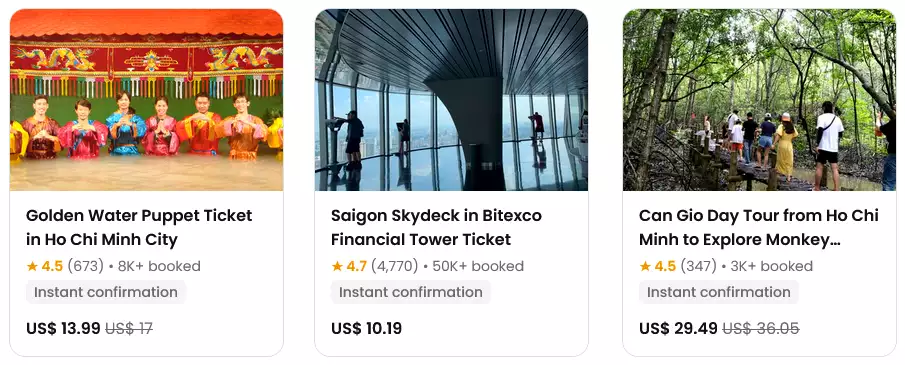
ℹ️ Information – Saigon
🛕 History + Culture
🛍️ Shopping in Saigon
🚣♀️ Visit Mekong Delta
🍜 What to eat in Saigon
✈️ How to get to Saigon
☀️ Weather in Saigon
🏡 Where to stay in Saigon
🔍 Sightseeing in Saigon
❓ FAQ + Travel Tips + Info
🎫 Book a Tour in Saigon
🎫 Book Ticket to Saigon
Quick answer: Ho Chi Minh City, also known as Saigon, is a dynamic and fast-paced metropolis that blends rich history with modern energy. Visitors can explore impressive colonial-era landmarks, delve into Vietnam’s past at museums, enjoy vibrant street food scenes, and take in sweeping city views from rooftop bars. The bustling markets, lively nightlife, and riverside attractions offer something for every traveler seeking an authentic urban experience.
At a glance:
- 🏯 Historic Buildings: See the Saigon Opera House, Notre-Dame Cathedral, and Independence Palace.
- 🎨 Art & Museums: Visit the Fine Arts Museum and War Remnants Museum for deep cultural insight.
- 🛍️ Markets: Ben Thanh Market is great for food, crafts, and local life.
- 🌆 Skyline Views: Head to the Bitexco Skydeck for panoramic views over the city.
- 🚤 River Cruise: Cruise the Saigon River for a different perspective of the city.
- 🧘 Temples & Pagodas: Explore Vĩnh Nghiêm Pagoda for a moment of calm.
- 🌿 Parks & Squares: Relax at Turtle Lake or Chi Lăng Park in the urban core.
- 🗓️ Best Time to Visit: December–April is generally dry and warm — great for walking and sightseeing.
Last updated in November 2025
Location and Geography of Ho Chi Minh City:
-
- Ho Chi Minh City, also known as Saigon, is an urban marvel nestled in the southern part of Vietnam. Its geographical position paints a picture of dynamism and allure, captivating both locals and tourists alike. Situated gracefully on the eastern bank of the Saigon River, the city enjoys a strategic location approximately 50 kilometers (31 miles) from the South China Sea. This proximity grants visitors the chance to relish captivating vistas of cerulean waters and pristine sandy beaches. It is also a good option to visit Saigon, because from here you can travel to Phnom Penh in Cambodia.
- The topography of Ho Chi Minh City is characterized by a gentle and level terrain, bestowing a sense of openness upon the landscape. With an average elevation barely exceeding a few meters above sea level, the city finds its place in the embrace of the sprawling Mekong Delta. This fertile region, sculpted by the mighty Mekong River in southern Vietnam and its tributaries, gifts the city with fertile alluvial soils, fostering abundant agricultural productivity.
- Within the boundaries of Ho Chi Minh City, a microcosm of diversity unfolds. Its districts and provinces, each possessing a distinct character, encircle the city. At its pulsating heart lies District 1, the vibrant nucleus of commerce and finance, where lofty skyscrapers, luxurious hotels, and bustling shopping streets thrive. District 3, with its French colonial architecture, emanates a nostalgic aura, while District 5 beckons with the allure of its vibrant Chinatown.
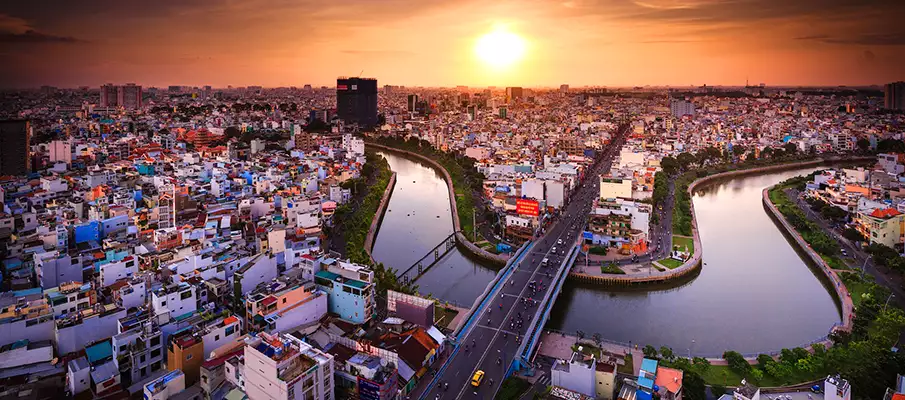
History and Culture of Ho Chi Minh City:
-
- Ho Chi Minh City, previously known as Saigon, boasts a captivating history that has shaped its vibrant culture. From its origins as a Khmer settlement to its transformation under French colonial rule and its pivotal role during the Vietnam War, the city’s past is evident in its diverse architecture and resilient spirit. Today, Ho Chi Minh City is a dynamic hub that blends tradition and modernity, offering a bustling street life, a culinary scene that tantalizes the taste buds with traditional delicacies and international flavors, a thriving arts and entertainment scene, and a warm and welcoming atmosphere.
- The city’s temples and pagodas, along with iconic landmarks like the Notre-Dame Cathedral, serve as reminders of its religious and colonial heritage. Festivals and celebrations, such as the lively Lunar New Year festivities, showcase the city’s vibrant cultural tapestry. Ho Chi Minh City is a place where history comes alive, inviting visitors to explore its past while immersing themselves in its lively and ever-evolving present.
- Ho Chi Minh City is a living testament to resilience, adaptability, and the enduring spirit of its people. Its history and culture intertwine, creating an intoxicating blend of old and new, tradition and innovation. As you wander its bustling streets, immerse yourself in its rich heritage, and engage with its friendly residents, you’ll discover a city that is simultaneously rooted in the past and poised for the future, inviting you to become a part of its captivating story.
Saigon played a crucial role in the Vietnam War:
-
- During the Vietnam War, Saigon, played a pivotal role as the political and military hub of South Vietnam. The city served as the capital of South Vietnam and the seat of a government supported by the United States, which fought against the communist North Vietnam. Saigon witnessed significant events, including the Tet Offensive in 1968, which had a profound impact on the course of the war. In 1975, Saigon was captured by communist forces from North Vietnam, marking the end of the Vietnam War and the reunification of the country. This event was a crucial milestone in Vietnamese history and had lasting effects on the political, societal, and cultural landscape of Vietnam.
BOOK a TOUR / ACTIVITY in Saigon ➜
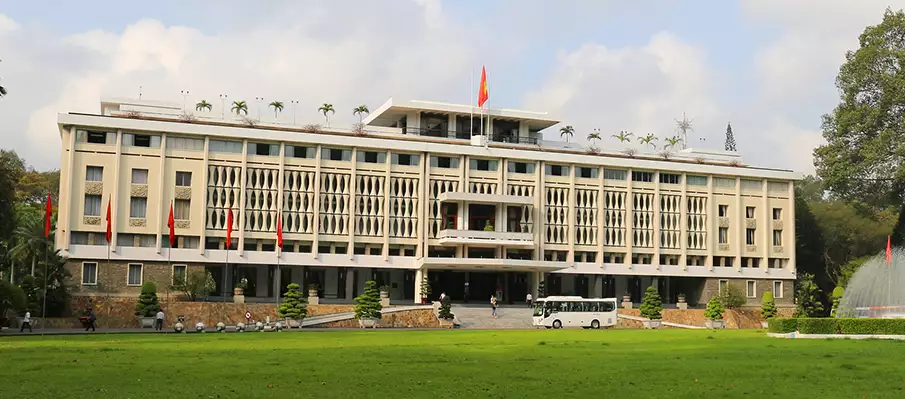
Festivals and Events in Ho Chi Minh City:
Ho Chi Minh City is a vibrant metropolis that hosts a multitude of festivals and events throughout the year, offering visitors a chance to immerse themselves in the city’s rich cultural tapestry. From traditional celebrations steeped in history to modern cultural festivals, there’s always something happening in this dynamic city. Here are a few notable festivals and events in Ho Chi Minh City:
-
- Tet Festival (Lunar New Year): Tet is the most important and widely celebrated festival in Vietnam, marking the arrival of the Lunar New Year. In Ho Chi Minh City, the streets come alive with colorful decorations, lion dances, and bustling markets selling traditional foods and gifts. Fireworks illuminate the night sky as families gather to pay respects to ancestors and exchange good wishes for the year ahead.
- Reunification Day (April 30th): Reunification Day commemorates the fall of Saigon and the reunification of Vietnam under communist rule in 1975. The city celebrates with parades, cultural performances, and fireworks, showcasing the resilience and unity of the Vietnamese people.
- Southern Fruit Festival: Held annually during the summer months, the Southern Fruit Festival celebrates the abundance of tropical fruits in the region. Visitors can savor a wide variety of delicious fruits, participate in fruit-related activities and contests, and enjoy cultural performances highlighting the agricultural heritage of the Mekong Delta.
- Ao Dai Festival: The Ao Dai, Vietnam’s traditional long dress, takes center stage during this festival. Held in March, it showcases the elegance and beauty of this iconic garment through fashion shows, exhibitions, and cultural performances. The festival promotes the preservation of Vietnamese traditional costumes and celebrates the artistry and craftsmanship behind the Ao Dai.
- Vietnamese Women’s Day (October 20th): This day honors the contributions of Vietnamese women to society. Ho Chi Minh City commemorates the occasion with various events, including concerts, art exhibitions, and cultural performances, celebrating the achievements and empowerment of women.
- Ho Chi Minh City Marathon: Fitness enthusiasts and avid runners can participate in the Ho Chi Minh City Marathon, an annual event held in January. The race offers different distances for participants of all levels, showcasing the city’s landmarks as runners traverse its streets.
- Christmas and New Year Celebrations: Although Christmas is not traditionally celebrated in Vietnam, Ho Chi Minh City embraces the festive spirit, especially in the city center. Streets are adorned with lights, and shopping malls and hotels display dazzling decorations. Many restaurants and bars offer special holiday menus and entertainment, making it a lively time to visit the city.
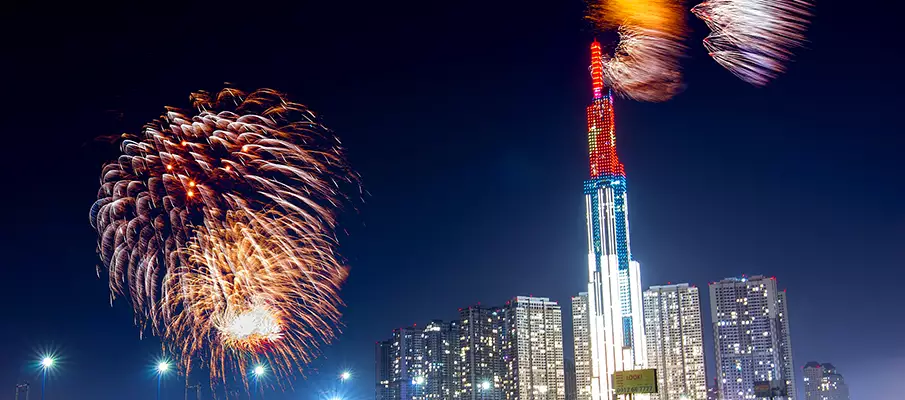
Economy in Ho Chi Minh City (is still growing):
-
- Ho Chi Minh City stands as a bustling economic powerhouse, driving Vietnam’s growth and serving as a regional economic leader. The city’s economy is characterized by its diversity and resilience, with thriving sectors spanning finance, commerce, manufacturing, technology, tourism, and services. It boasts a robust financial sector, hosting major banks and financial institutions, while also attracting multinational corporations seeking to establish their presence in Southeast Asia.
- Manufacturing plays a significant role, with industries ranging from textiles and garments to electronics and automotive, driving exports and contributing to the global supply chain. Ho Chi Minh City’s vibrant tourism sector attracts a steady stream of visitors, capitalizing on its rich history, cultural heritage, and vibrant street life. The city has also embraced digital innovation, fostering a dynamic startup ecosystem that fuels entrepreneurship and technological advancements.
- With a large and skilled workforce, Ho Chi Minh City offers abundant employment opportunities, attracting talent from across Vietnam. In essence, Ho Chi Minh City’s economy thrives through its diverse sectors, favorable business climate, and forward-thinking approach, positioning it as a driving force behind Vietnam’s economic success.
Book your Accommodation in Saigon ➜
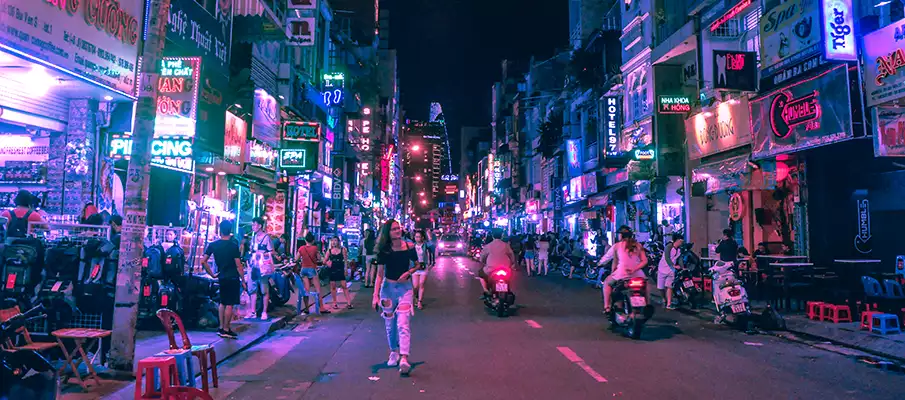
Tourism and Activities in Ho Chi Minh City:
-
- Tourism in Ho Chi Minh City offers a captivating blend of rich history, vibrant culture, and bustling city life. As Vietnam’s largest city, it attracts a steady flow of visitors eager to explore its diverse attractions.
- Ho Chi Minh City preserves its historical charm through landmarks like the Notre-Dame Cathedral, the Reunification Palace, and the War Remnants Museum, which provide insights into its colonial past and the Vietnam War. The city’s vibrant street life, bustling markets, and lively neighborhoods like Ben Thanh Market and Bui Vien Walking Street immerse visitors in the local culture and culinary delights.
- The city’s thriving arts and entertainment scene offers a range of experiences, from traditional music and dance performances to contemporary art exhibitions and live music venues. Ho Chi Minh City also serves as a gateway to the Mekong Delta, allowing tourists to embark on scenic river cruises and explore the rural beauty and floating markets of the region.
- Food enthusiasts can indulge in the city’s renowned street food scene, with flavorsome dishes like pho, banh mi, and fresh seafood readily available in vibrant markets and humble roadside stalls. Modern shopping malls and boutiques cater to fashion lovers, while traditional craft villages offer unique handicrafts and souvenirs.
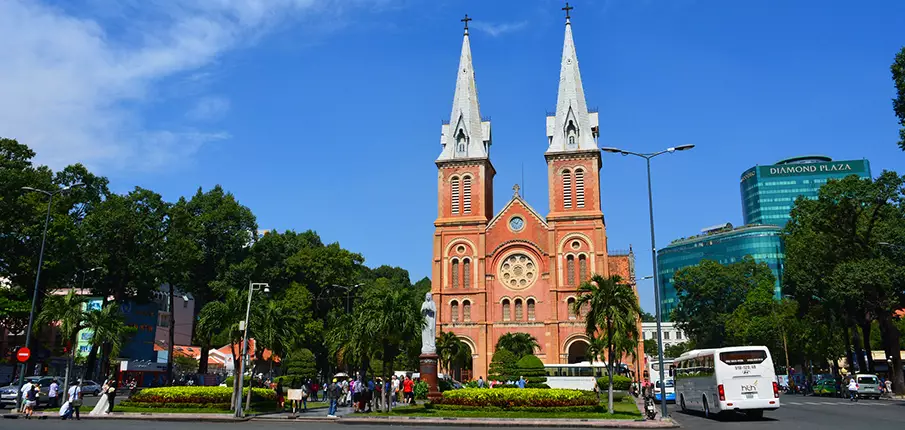
10 Key Historical Buildings and Sites in Ho Chi Minh City:
Ho Chi Minh City, the splendid metropolis of Southeast Asia, holds within its urban hustle and bustle several historical treasures. These architectural gems narrate the city’s story and its evolution. Here are 10 of the most important historical buildings and sites you must not miss during your visit:
-
- Notre-Dame Cathedral: This majestic church with its red brick towers embodies colonial heritage. Built in the 19th century following Gustave Eiffel’s design, the cathedral still captivates visitors with its impressive appearance.
- Central Post Office: A building of Neo-Renaissance architecture, this is not only a visual delight but also a place steeped in history. Designed by the renowned architect Gustave Eiffel, it still functions as a working post office and a meeting place.
- War Remnants Museum: An integral part of the city’s history, the War Remnants Museum documents the harrowing events of the Vietnam War. The exhibits feature artifacts, photographs, and relics that reflect the historical reality of that time.
- Reunification Palace: Known as the Independence Palace, this former residence of the South Vietnamese president now serves as a museum and cultural landmark. Visitors can explore presidential offices, the underground communication center, and picturesque gardens.
- Cholon – Old Chinese Quarter: This historic city center, also known as the Chinese Quarter, is brimming with traditional Chinese houses, colorful temples, and markets. Cholon offers an authentic glimpse into rich cultural heritage and traditions.
- Former Research House (Maison Centrale): Also known as the „House of Prison,“ this historical structure stands as evidence of Vietnam’s darker history. Built during the French colonial era, it served as a prison for political prisoners, including those who fought for Vietnam’s independence.
- Fine Arts Museum: The Ho Chi Minh City Museum of Fine Arts is home to an extensive collection of Vietnamese art, from traditional to contemporary. Visitors can discover artistic treasures from various periods and genres.
- Saigon Opera House: This magnificent building, also known as the Municipal Theatre, represents a blend of French architectural styles. Constructed in the late 19th century, it has hosted countless cultural performances, including opera, ballet, and theater.
- Cho Quan Church: Cho Quan Church, also known as St. Francis Xavier Church, is a historical Catholic church located in the Cholon district. Cho Quan is the old Chinese district, and this church is an important part of the cultural and religious heritage of the area.
- Thien Hau Temple: This impressive Chinese temple showcases the city’s rich cultural diversity. Dedicated to the goddess Thien Hau, the temple entices visitors with its intricately carved pink marble, tile mosaics, and stunning architecture.
These historical buildings not only contribute to the city’s architectural landscape but also hold historical and cultural significance. They serve as reminders of the city’s past and invite visitors to explore and appreciate Saigon’s unique heritage.
BOOK a TOUR / ACTIVITY in Saigon ➜

Best Shopping Places / Markets in Ho Chi Minh City:
Ho Chi Minh City, also known as Saigon, is not only a cultural and historical treasure but also a paradise for shopping enthusiasts. The city offers diverse shopping options, from modern shopping centers to traditional markets. Here are some of the best places where you can enjoy a unique shopping experience:
-
- Bến Thành Market: This historic market is the heart of the city, offering a wide range of products including clothing, souvenirs, leather goods, and traditional Vietnamese dishes. It’s an ideal place for souvenir shopping and sampling local delicacies.
- Saigon Centre: Saigon Centre is a modern shopping center that is a haven for fashion enthusiasts. Here, you’ll find the latest fashion trends, luxury brands, cosmetics, and electronics.
- Dong Khoi Street: This prestigious street is full of boutiques, branded clothing stores, and designer accessories. It’s a place where you can discover local and international fashion designs.
- Cholon – Chinatown: If you’re seeking authentic experiences, Chinatown offers traditional markets with spices, medicinal herbs, fabrics, and much more. It’s a place where ancient traditions blend with modern trends.
- Takashimaya Vietnam: Everyone can enjoy this Japanese shopping center, offering quality goods, luxury products, and exclusive brands. It also features Japanese cuisine and cosmetic products.
- Saigon Square: This favorite spot offers fashionable clothing, footwear, and accessories at affordable prices. It’s an ideal place for those seeking trendy pieces without the high price tag.
- Union Square Saigon: This modern complex combines shopping, entertainment, and gastronomy. It offers many boutiques, restaurants, cafes, and even a cinematic experience.
- Bitexco Financial Tower – The Garden Mall: At the top of the iconic Bitexco Tower, you’ll find a shopping center with a view of the city. Here, you can shop, relax, and admire the panoramic view from a popular observation point.
Ho Chi Minh City is a shopping paradise where you can discover both modern trends and traditional goods. Whether you’re looking for fashion, souvenirs, or cultural experiences, this city has it all.
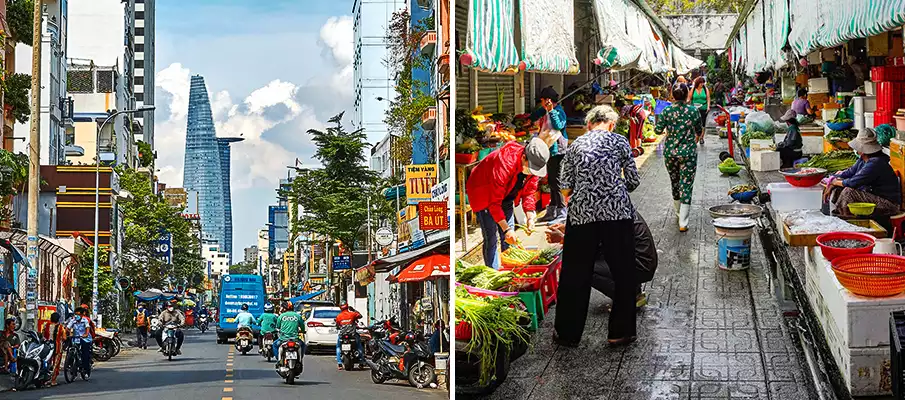
The Cu Chi Tunnels: A Journey Through History.
When visiting Ho Chi Minh City, one of the most iconic historical sites to explore is the Cu Chi Tunnels. Located approximately 70 kilometers northwest of the city center, these underground passages played a crucial role during the Vietnam War. Today, they are a testament to the resilience and ingenuity of the Vietnamese people. In this article, we’ll take you on a journey through these fascinating tunnels and provide some useful tips for your visit.
The Cu Chi Tunnels – A Brief History:
-
- The Cu Chi Tunnels are an extensive network of underground tunnels that were used by the Viet Cong, the communist forces during the Vietnam War, as a means to evade enemy troops and launch guerilla attacks. Stretching over 250 kilometers, this intricate web of tunnels allowed the Viet Cong to move, live, and fight beneath the surface, effectively creating an underground village.
- Visitors to the Cu Chi Tunnels can explore sections of the tunnels and gain insights into the life of the soldiers who lived there. You can witness the trapdoors, booby traps, and hidden entrances used to thwart American and South Vietnamese forces. It’s a gripping experience that provides a window into the past.
Useful Tips for Your Visit:
-
- Plan Your Visit Early: The Cu Chi Tunnels are a popular attraction, so it’s advisable to arrive early to avoid the crowds and the midday heat.
- Guided Tours: Consider joining a guided tour. Knowledgeable guides can offer valuable historical context and make your experience more engaging. You can book a tour in advance or upon arrival.
- Comfortable Clothing: Wear comfortable clothing and closed-toe shoes as you’ll be walking through uneven terrain and exploring narrow tunnels. Also, don’t forget to apply sunscreen and wear a hat for sun protection.
- Water and Snacks: It’s important to stay hydrated, so bring a bottle of water. There are some food stalls and small restaurants nearby, but having a few snacks on hand is a good idea.
- Respect the History: While exploring, be respectful of the tunnels and the history they represent. Avoid touching or tampering with any artifacts, as they are an essential part of the preservation efforts.
- Camera Ready: Don’t forget your camera. You’ll want to capture the unique experience of crawling through the tunnels and exploring this historic site.
- Souvenirs: There are souvenir shops at the site. You may find interesting mementos, but be prepared to haggle over prices in local markets.
- Travel Time: The trip to the Cu Chi Tunnels can take a few hours, including travel to and from Ho Chi Minh City. Plan your day accordingly.
- Understand the Tunnels: Before your visit, take some time to read about the history of the tunnels and the Vietnam War. This background knowledge will enhance your experience.
- Respect Local Customs: Remember to be respectful of local customs and traditions. The Cu Chi Tunnels are a solemn place for many Vietnamese, so be mindful of your behavior.
Book your Accommodation in Saigon ➜
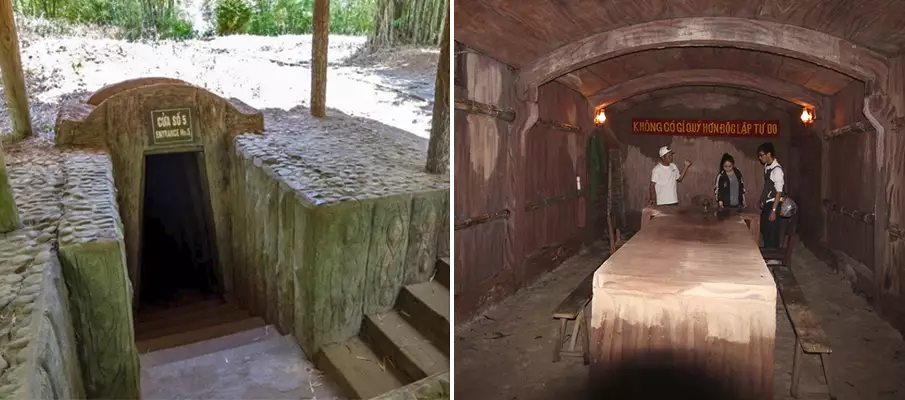
Unveiling History at the War Remnants Museum in Saigon.
Ho Chi Minh City, formerly known as Saigon, is a city that reverberates with history. One of its most poignant reminders of the tumultuous past is the War Remnants Museum. This museum stands as a testament to the indomitable spirit of the Vietnamese people during the Vietnam War and provides invaluable insights into the conflict. In this article, we will explore the significance of the War Remnants Museum and provide you with five useful tips for a meaningful visit.
The War Remnants Museum – A Glimpse into History:
-
- The War Remnants Museum, formerly known as the Museum of American War Crimes, is a museum that meticulously documents the harrowing events of the Vietnam War. Opened to the public in 1975, it houses an extensive collection of photographs, artifacts, and equipment from the war, serving as a powerful reminder of the past.
- Visitors can explore the museum’s numerous exhibitions, each offering a unique perspective on the war. From the effects of Agent Orange to the brutalities faced by prisoners of war, the museum doesn’t shy away from portraying the horrors of war. It also showcases the resilience of the Vietnamese people and their path to reconciliation and healing.
Useful Tips for Your Visit:
-
- Allocate Sufficient Time: The War Remnants Museum is extensive, and it’s recommended to allocate at least half a day for your visit. This will allow you to fully appreciate the depth of the exhibitions.
- Educate Yourself: Before visiting, take some time to read about the Vietnam War and its historical context. This will help you better understand the exhibits and their significance.
- Respectful Attire: As a mark of respect for the solemnity of the museum, dress modestly. Avoid wearing revealing or offensive clothing.
- Prepare Emotionally: The museum displays graphic images and descriptions of the war’s horrors. It can be emotionally challenging, so mentally prepare yourself for what you’re about to witness.
- Engage with Locals: While at the museum, you may have the opportunity to interact with local Vietnamese who can provide personal insights into the war and its impact on their lives. Engaging with them can be a profoundly enlightening experience.
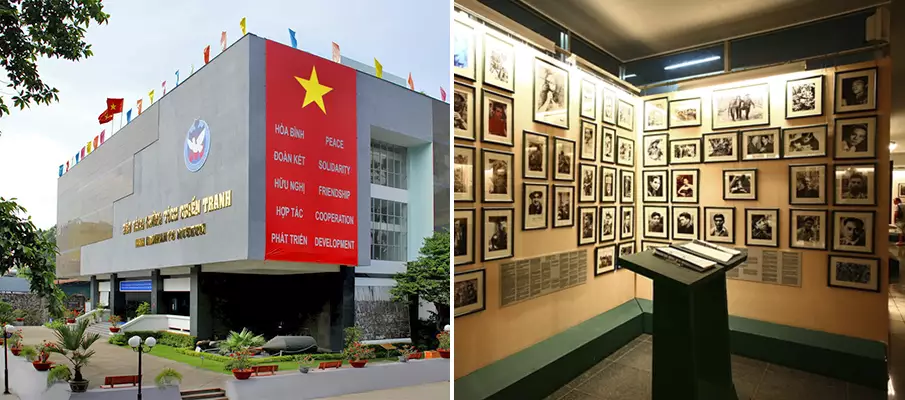
Landmark 81: Ho Chi Minh City’s Majestic Skyscraper:
Ho Chi Minh City, formerly known as Saigon, boasts a skyline that tells the story of Vietnam’s remarkable transformation over the years. And at the heart of this narrative stands an architectural marvel, Landmark 81.
-
- Redefining the Skyline: Landmark 81 is more than just a skyscraper; it’s a symbol of Vietnam’s rapid economic growth and modernity. Located in the heart of Ho Chi Minh City’s District 2, this towering structure pierces the sky at a breathtaking 461 meters (1,514 feet) in height. As of its completion in 2018, it claimed the title of Southeast Asia’s tallest building and the 14th tallest in the world.
- A Symphony of Design and Innovation: Landmark 81’s design is a fusion of modernity and Vietnamese cultural elements. Its sleek glass facade is adorned with traditional bamboo motifs, paying homage to the country’s rich heritage. Inside, the building houses a shopping mall, luxurious apartments, a hotel, and an observation deck on the 79th floor, offering panoramic views of the bustling city below.
- Luxury Living and More: For those fortunate enough to call Landmark 81 home, it offers a lifestyle that’s second to none. The residential floors are outfitted with top-tier amenities, including infinity pools, fitness centers, and spacious gardens. The Vinpearl Landmark 81 Hotel within the building provides world-class hospitality, making it a magnet for both tourists and business travelers.
- A Culinary Haven: Food enthusiasts will find their taste buds dancing with delight within Landmark 81. The complex hosts a diverse range of restaurants, serving local Vietnamese cuisine, international fare, and everything in between. It’s a culinary journey that showcases the cultural diversity of the city.
- A Hub for Business and Leisure: Aside from the marvel of Landmark 81’s architecture, it serves as a hub for business and leisure activities. With its proximity to other key landmarks, such as the Saigon River, the Vinhomes Central Park, and the bustling District 1, the skyscraper is a magnet for locals and tourists alike.
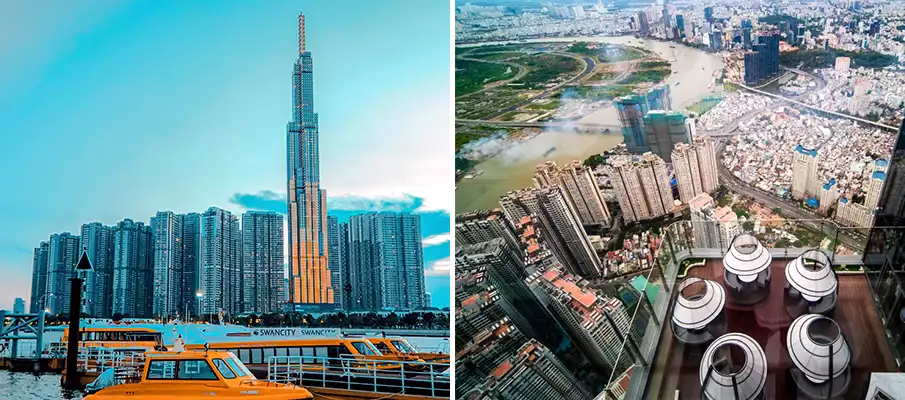
Visit Fascinating Saigon Skydeck at Bitexco Financial Tower:
Ho Chi Minh City, the bustling metropolis of Vietnam, offers a plethora of captivating sights, but none quite compare to the breathtaking view from the Saigon Skydeck at the Bitexco Financial Tower. Perched atop one of the city’s most iconic skyscrapers, this vantage point provides a panoramic perspective of the city’s splendor.
-
- A Marvel of Modern Architecture: The Bitexco Financial Tower itself is a testament to modern architectural brilliance. Standing at 262 meters (860 feet), it was the tallest building in Vietnam when it opened in 2010. Its unique design, resembling the shape of a lotus bud, captures the essence of traditional Vietnamese culture blended with contemporary innovation.
-
- The Saigon Skydeck Experience: The Saigon Skydeck, located on the 49th floor of the Bitexco Financial Tower, is the highlight of this architectural wonder. As you step out of the elevator onto the observation deck, you are greeted with stunning 360-degree views of the cityscape. From this vantage point, you can witness the Saigon River meandering through the city, witness the bustling streets below, and admire the contrast between historic landmarks and the glitzy modern skyline.
-
- Day and Night Magic: The view from the Saigon Skydeck is magical at any time of day, but it truly comes to life as the sun dips below the horizon. The city’s transformation from the vibrant daylight to a glittering sea of lights is a sight to behold. This transition captures the energetic spirit of Ho Chi Minh City.
-
- Capturing Memories: For visitors, the Skydeck offers a chance to capture incredible memories. Whether it’s a selfie with the cityscape as your backdrop or a romantic moment watching the sunset, this is an ideal spot to document your journey.
-
- Dining in the Clouds: If you’re looking for a memorable dining experience, the Bitexco Financial Tower also houses the EON Heli Bar and Restaurant on the 51st and 52nd floors. Savoring a delicious meal or a cocktail while gazing at the city below is an experience like no other.
-
- A Must-Visit Attraction: The Saigon Skydeck at Bitexco Financial Tower is an attraction that should not be missed during your visit to Ho Chi Minh City. It offers a unique opportunity to appreciate the city from a whole new angle and to gain an understanding of its vibrant culture and rapid development.
BOOK a TOUR / ACTIVITY in Saigon ➜
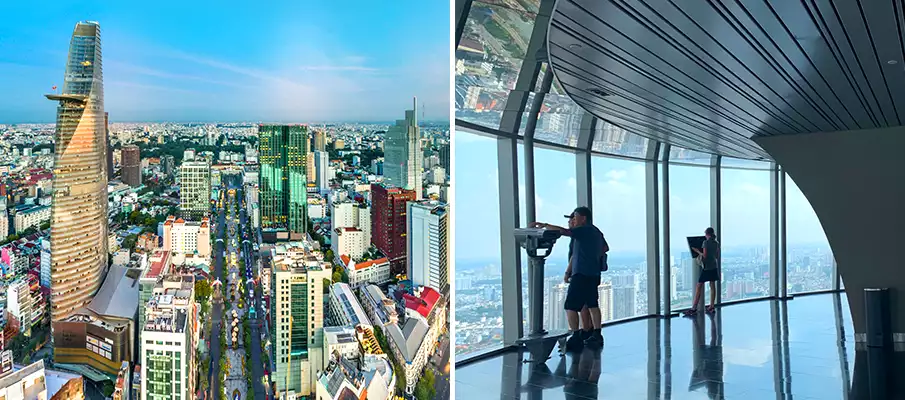
Exploring the Heart of Ho Chi Minh City: Ben Thanh Market.
Amidst the lively streets of Ho Chi Minh City, the iconic Ben Thanh Street Food Market stands as a testament to the city’s vibrant culture, history, and commerce. Located in the heart of District 1, this bustling market is a treasure trove of local flavors, crafts, and traditions.
-
- A Historical Gem: Ben Thanh Streed Food Market (also called Ben Nghe Market), with its distinctive clock tower, has been a fixture in the city since the late 19th century. Originally a gathering place for local vendors, it has transformed into an essential destination for both locals and tourists alike. Its history is woven into the fabric of Saigon’s development over the decades.
-
- Shop Till You Drop: The market is a shopper’s paradise. From clothing and textiles to handmade crafts, jewelry, and souvenirs, Ben Thanh offers a wide array of goods to peruse. Be prepared to haggle, as bargaining is a customary practice here. It’s all part of the fun and a chance to engage with the friendly locals.
-
- Culinary Delights: One of the highlights of Ben Thanh Market is its food section. Hungry visitors can sample an assortment of Vietnamese street food, from pho and banh mi to fresh seafood and tropical fruits. The aroma of sizzling dishes and the enticing flavors will leave you craving for more.
-
- A Cultural Experience: Ben Thanh Market is a melting pot of cultures. As you explore the market’s various stalls, you’ll encounter a diverse mix of people, all contributing to the market’s unique atmosphere. It’s an opportunity to engage with locals, learn about their customs, and gain insights into everyday life in the city.
-
- Authentic Souvenirs: If you’re seeking authentic souvenirs to remember your trip to Ho Chi Minh City, this is the place to find them. Locally crafted items, such as lacquerware, conical hats, and traditional musical instruments, are readily available. These mementos are not only beautiful but also carry the essence of Vietnamese culture.
-
- A Must-Visit Icon: Ben Thanh Market is not just a marketplace; it’s a cultural landmark that showcases the spirit of Ho Chi Minh City. Whether you’re an avid shopper, a food lover, or a traveler eager to immerse yourself in local life, this market is a must-visit.
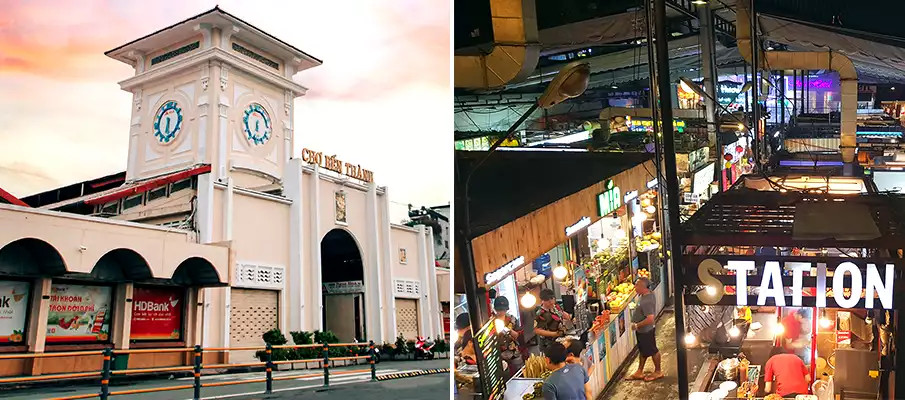
Escape to Mekong Delta Region (+Floating Markets):
-
- The Mekong Delta region is a mesmerizing tapestry of natural beauty and rural charm located in southwestern Vietnam. Spanning across lush plains and interwoven with a vast network of rivers and canals, this fertile region is often referred to as the „rice bowl“ of Vietnam. It is also a popular site for various floating markets, like in My Tho, Can Tho or Soc Trang, these places are accessible by bus or motorbike, taxi from Saigon.
- The Mekong Delta captivates visitors with its picturesque landscapes, characterized by vibrant green rice paddies, coconut groves, and floating markets bustling with activity. Traveling along the waterways on a traditional sampan boat offers a unique perspective, allowing you to witness the daily lives of locals as they engage in fishing, farming, and trading.
- Exploring the Mekong Delta provides an opportunity to delve into the region’s rich cultural heritage. Traditional craft villages dot the area, showcasing skilled artisans practicing age-old techniques in producing items such as ceramics, handicrafts, and coconut candy. Immersing yourself in the local customs and festivities offers a deeper understanding of the region’s cultural tapestry.
- Culinary enthusiasts are in for a treat as the Mekong Delta is renowned for its diverse and flavorful cuisine. Sample fresh tropical fruits, indulge in seafood delicacies, and savor local specialties such as „hu tieu“ noodles and „ca nuong“ (grilled fish) prepared with aromatic herbs and spices.
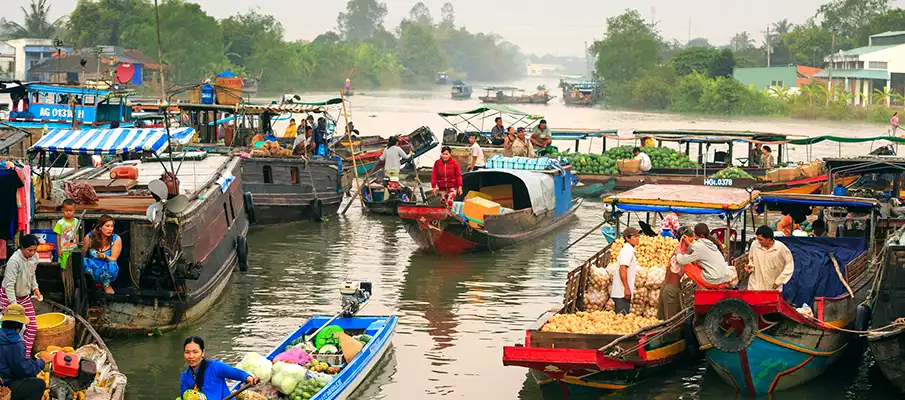
Why to visit or not to visit Ho Chi Minh City?
Ultimately, whether or not to visit Ho Chi Minh City depends on personal preferences and travel interests. While the city offers a vibrant and culturally rich experience, it may not be the ideal destination for those seeking a tranquil or nature-oriented getaway.
👉 Reasons to visit Ho Chi Minh City:
-
- Rich History and Culture: Ho Chi Minh City offers a captivating blend of history and culture, with landmarks, museums, and vibrant neighborhoods showcasing its colonial past and Vietnamese heritage.
- Vibrant City Life: The city’s bustling streets, lively markets, and vibrant nightlife create an energetic atmosphere, providing a glimpse into the dynamic urban lifestyle of Vietnam.
- Delicious Cuisine: Ho Chi Minh City is a food lover’s paradise, offering a wide range of delectable Vietnamese dishes, street food, and international cuisine, satisfying every palate.
- Architectural Marvels: The city boasts impressive architectural gems, including French colonial buildings, religious monuments, and modern skyscrapers, showcasing a blend of influences and styles.
- Warm Hospitality: The people of Ho Chi Minh City are known for their friendliness and warm hospitality, creating a welcoming and memorable experience for visitors.
👉 Reasons not to visit Ho Chi Minh City:
-
- Crowded and Chaotic: The city can be crowded and hectic, especially during peak hours, which might not appeal to those seeking a more peaceful and relaxed environment.
- Traffic Congestion: Ho Chi Minh City’s traffic can be overwhelming, with heavy congestion and a lack of pedestrian-friendly areas, making it challenging for some travelers to navigate.
- Hot and Humid Climate: The city experiences a hot and humid climate throughout the year, which may not be suitable for those who prefer milder or cooler temperatures.
- Noise and Pollution: Due to its urban nature, Ho Chi Minh City can be noisy, with traffic, construction, and bustling street life contributing to noise pollution. Additionally, air pollution levels can be high in certain areas.
- Lack of Nature and Green Spaces: For those seeking abundant natural landscapes and green spaces, Ho Chi Minh City may not fulfill those expectations as it is primarily an urban environment with limited access to nature.
Book your Accommodation in Saigon ➜
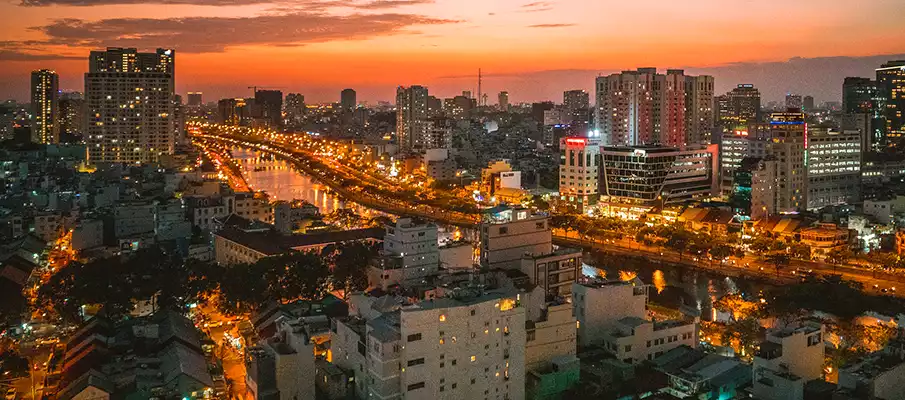
What to eat and taste in Ho Chi Minh City:
Ho Chi Minh City boasts a culinary scene that is rich, diverse, and tantalizing to the taste buds. From traditional Vietnamese delicacies to international flavors, the city offers a delightful gastronomic experience. Here is a short description of the cuisine in Ho Chi Minh City:
-
- Pho: A must-try Vietnamese dish, pho is a flavorful noodle soup typically made with beef or chicken, accompanied by fresh herbs, bean sprouts, and lime. It’s a beloved dish that embodies the essence of Vietnamese cuisine.
- Banh Mi: This iconic Vietnamese sandwich combines French influence with local ingredients. A crusty baguette is filled with a variety of fillings such as grilled meats, pate, pickled vegetables, and herbs, creating a perfect balance of flavors and textures.
- Com Tam: Translating to „broken rice,“ com tam is a popular dish made with fragrant rice grains that are fractured during the milling process. It is typically served with grilled pork chops, a fried egg, pickled vegetables, and a side of fish sauce, creating a delightful and satisfying meal.
- Banh Xeo: Known as Vietnamese pancakes or sizzling crepes, banh xeo is a savory delight. Made with a rice flour batter, filled with shrimp, pork, bean sprouts, and herbs, it is cooked until crispy and served with fresh lettuce leaves for wrapping.
- Seafood Delights: Being a coastal city, Ho Chi Minh City offers an array of fresh and flavorful seafood dishes. From succulent grilled prawns to aromatic fish curries, seafood lovers will be in for a treat.
- Vietnamese Coffee: Don’t miss the opportunity to savor Vietnamese coffee. Strong and rich, it is often served with condensed milk over ice, creating a sweet and refreshing beverage that will keep you energized throughout the day.
- Street Food: Ho Chi Minh City is famous for its vibrant street food scene. Wander through the bustling streets and sample delights like banh cuon (steamed rice rolls), goi cuon (fresh spring rolls), and banh trang nuong (grilled rice paper with toppings), all readily available from street vendors.
In summary, Ho Chi Minh City’s cuisine offers a delightful exploration of flavors, from iconic Vietnamese dishes to a fusion of international influences. Whether you’re indulging in traditional street food or dining in upscale establishments, the city’s culinary offerings promise to satisfy even the most discerning palate.
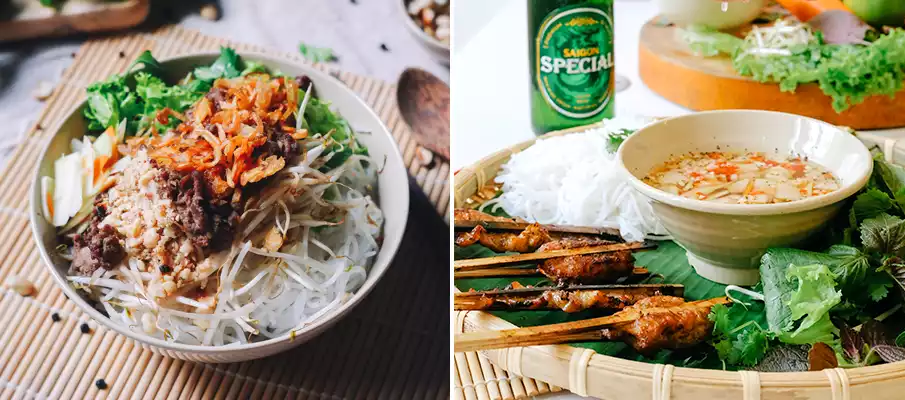
✈️ How to get and travel to Ho Chi Minh City?
Getting to and traveling within Saigon, also known as Ho Chi Minh City, is relatively straightforward. Ho Chi Minh City is the biggest and important transport hub in southern Vietnam. Here are some common transportation options, available also for tourists visiting this city:
-
- By Air: The most convenient way to reach Saigon is by flying into Tan Son Nhat International Airport (SGN), which serves both domestic and international flights. From the airport, you can easily take a taxi or ride-sharing service to your destination in the city.
- By Train: Saigon has a train station called Saigon Railway Station, located in District 3. However, train travel to Saigon is more commonly used for domestic routes within Vietnam rather than international travel.
- By Bus / Van: Buses are a popular mode of transportation for getting to Saigon from nearby cities and provinces. There are several bus companies operating routes to and from Saigon, offering both standard and luxury options. The city also has a well-connected local bus network for getting around within Saigon itself.
- By Car: If you prefer driving, you can rent a car and drive to Saigon. However, be aware that traffic in the city can be busy and chaotic, so it’s essential to be prepared for the driving conditions and follow local traffic rules.
- By Motorbike: Renting a motorbike is a popular option for exploring Saigon. It allows for flexibility and easier navigation through the city’s narrow streets. However, it’s important to have prior experience riding a motorbike and always wear a helmet for safety.
- Within the City: Saigon has various transportation options for getting around the city. Taxis, ride-sharing services like Grab, and motorbike taxis (known as „xe om“) are readily available. The city also has a network of public buses, though they can be crowded at times. Walking is another option for shorter distances, particularly in the central areas where many attractions are within walking distance of each other.
-
- Book and buy tickets / flights to Saigon in Vietnam on Baolau ➜ or 12go.asia ➜.

☀️ Weather in Saigon + The Best Time to Visit:
Weather in Saigon, also known as Ho Chi Minh City, is characterized by a tropical climate with high humidity and distinct wet and dry seasons. Here’s an overview of the weather patterns and the best time to visit:
-
- The dry season in Saigon typically runs from December to April. During this time, the weather is generally hot and humid, with average temperatures ranging from 25°C (77°F) to 35°C (95°F). The skies are often clear, making it an ideal time for outdoor activities and exploring the city.
- The wet season in Saigon spans from May to November, with the peak rainfall occurring from June to September. Showers and thunderstorms are common during this period, typically in the afternoon or evening. The humidity levels remain high, and temperatures range from 25°C (77°F) to 32°C (90°F). It’s worth noting that despite the rain, the city remains bustling and vibrant, and it’s still possible to enjoy your visit with proper planning.
- The best time to visit Saigon is during the dry season from December to April. The pleasant weather and lower chance of rain make it an ideal time to explore the city’s attractions, markets, and outdoor sites comfortably. f you don’t mind occasional rain showers and prefer fewer crowds, the shoulder months of November and May can also be a good time to visit. The city is less crowded, and hotel rates may be more affordable. ➜ Current weather in Saigon.
| Month | Weather | Description |
|---|---|---|
| January | Mild and Dry | January in Ho Chi Minh City is characterized by mild temperatures and dry weather, providing comfortable conditions for exploring the city’s vibrant street life and historical attractions. |
| February | Mild and Dry | February continues the mild and dry weather, making it an ideal time to visit Ho Chi Minh City’s markets, museums, and indulge in the city’s famous street food. |
| March | Warm and Dry | March brings warmer temperatures and dry weather to Ho Chi Minh City, creating favorable conditions for outdoor activities, exploring the bustling city streets, and visiting nearby Cu Chi Tunnels. |
| April | Hot and Dry | In April, Ho Chi Minh City experiences hot and dry conditions, with high temperatures and plenty of sunshine. It is a great time to explore the city’s landmarks and enjoy the local cuisine. |
| May | Hot and Wet | May continues with hot temperatures and increased rainfall, providing a balance between exploring indoor attractions like museums and enjoying outdoor markets and city parks. |
| June | Hot and Wet | June is characterized by hot and wet weather in Ho Chi Minh City, with occasional showers and high humidity. It is a quieter month, perfect for exploring indoor museums and experiencing local culture. |
| July | Hot and Wet | Similar to June, July remains hot and wet, with increased rainfall. It is a good time to visit Ho Chi Minh City’s historical sites, enjoy local cuisine, and experience traditional festivals. |
| August | Hot and Wet | August continues the hot and wet weather pattern, with frequent showers and high humidity. It is a great time to explore the city’s markets, try street food, and experience the vibrant nightlife. |
| September | Hot and Wet | September in Ho Chi Minh City is hot and wet, with intermittent showers and high humidity. It is a good time to visit the city’s temples, indulge in Vietnamese cuisine, and experience local traditions. |
| October | Warm and Wet | October brings warm temperatures and increased rainfall to Ho Chi Minh City, offering a quieter time to explore indoor museums, indulge in local coffee culture, and visit nearby historical sites. |
| November | Mild and Dry | As November arrives, Ho Chi Minh City experiences milder temperatures and dry weather, making it an ideal month for exploring the city’s markets, enjoying rooftop bars, and taking day trips to the Mekong Delta. |
| December | Mild and Dry | December in Ho Chi Minh City is characterized by mild temperatures and dry weather, providing a pleasant atmosphere for exploring historical landmarks, shopping, and enjoying the city’s festive atmosphere. |
🏡 Accommodation in Ho Chi Minh City:
Ho Chi Minh City, formerly known as Saigon, offers a wide range of accommodation options to suit various budgets and preferences. Whether you’re a budget traveler looking for affordable hostels or a luxury seeker in search of high-end hotels, the city has something for everyone. Here are some popular accommodation options in Ho Chi Minh City:
-
- Hotels: Ho Chi Minh City boasts a plethora of hotels, ranging from budget-friendly options to luxury establishments. District 1, specifically the areas around Dong Khoi Street and Nguyen Hue Boulevard, is known for its upscale hotels with modern amenities and excellent service. These hotels often feature rooftop pools, spas, and panoramic city views.
- Hostels: For budget-conscious travelers or backpackers, hostels provide affordable and sociable accommodation. District 1 and the nearby Pham Ngu Lao Street are popular areas for hostels, offering dormitory-style rooms and private rooms at budget-friendly rates. Hostels are a great option for meeting fellow travelers and exploring the city together.
- Serviced Apartments: Ideal for long-term stays or travelers seeking a more independent experience, serviced apartments are available in various districts of Ho Chi Minh City. These apartments come with amenities like kitchenettes, living areas, and often provide housekeeping services. They offer a home-like environment for those who prefer more space and privacy.
- Boutique Hotels: Ho Chi Minh City is known for its charming boutique hotels that showcase Vietnamese aesthetics and cultural elements. These smaller-scale accommodations provide personalized service, unique decor, and a cozy ambiance. Many boutique hotels are situated in District 1, offering a blend of modern comforts and local charm.
- Airbnb: With the rise of home-sharing platforms, Airbnb offers a wide range of accommodation options in Ho Chi Minh City. From private rooms in local homes to entire apartments or villas, Airbnb provides a chance to experience the city like a local. It’s important to read reviews, check the location, before making a reservation.
➜ Accommodation in Saigon – Book Here ➜
🔍 Interesting Places + Activities in Saigon:
-
- Ben Thanh Market: Ben Thanh Market, located in the heart of Ho Chi Minh City, Vietnam, is a vibrant and iconic marketplace that epitomizes the city’s bustling energy and rich culture. This historic market is a mecca for both locals and tourists, offering a diverse array of goods, from fresh produce and delectable street food to handicrafts, clothing, and souvenirs.
- War Remnants Museum: The War Remnants Museum in Ho Chi Minh City, Vietnam, is a poignant and thought-provoking institution that offers a deeply moving insight into the country’s tumultuous history. Formerly known as the „Museum of Chinese and American War Crimes,“ this museum primarily focuses on the Vietnam War and its aftermath, displaying a collection of powerful exhibits, photographs, and artifacts that depict the tragic consequences of the conflict.
- Notre-Dame Cathedral Basilica: The Notre-Dame Cathedral Basilica of Saigon, located in the heart of Ho Chi Minh City, is a stunning architectural masterpiece that stands as a symbol of both faith and colonial history. Built in the late 19th century by the French colonial government, this magnificent cathedral boasts a Gothic architectural style with its twin bell towers and intricate stained glass windows.
- Cu Chi Tunnels: The Cu Chi Tunnels, located near Ho Chi Minh City, Vietnam, are an intricate network of underground passages used during the Vietnam War. These tunnels, ingeniously designed for hiding and guerilla warfare, offer a compelling glimpse into the history of the conflict and the resilience of the Vietnamese people.
- Saigon Opera House: The Saigon Opera House, situated in Ho Chi Minh City, is a dazzling architectural gem that exudes old-world charm and elegance. Also known as the Municipal Theatre of Ho Chi Minh City, it showcases a harmonious blend of French colonial and neoclassical design.
- Bitexco Financial Tower: The Bitexco Financial Tower (+Saigon Skydeck), a striking skyscraper in Ho Chi Minh City, is a symbol of modernity and innovation in Vietnam. With its unique, helical design, it stands as one of the city’s most iconic landmarks.
- Reunification Palace: The Reunification Palace, located in Ho Chi Minh City, is a historically significant landmark that played a pivotal role in the reunification of Vietnam. Originally known as the Independence Palace, it was the site of the symbolic end of the Vietnam War when a North Vietnamese tank crashed through its gates in 1975. The palace’s architecture reflects the mid-20th century, with a modern and functional design.
- Saigon Central Post Office: The Saigon Central Post Office, located in the heart of Ho Chi Minh City, is a captivating blend of architectural beauty and historical significance. Designed by Gustave Eiffel, the mastermind behind the Eiffel Tower, this colonial-era post office is a stunning example of French neoclassical architecture. Inside, visitors are greeted by a grand, vaulted ceiling and ornate details.
- Landmark 81: Landmark 81 stands tall, both literally and symbolically, as a testament to Vietnam’s progress and its embrace of modernity while honoring its cultural roots. Whether you’re an architecture enthusiast, a luxury seeker, or simply someone looking to capture breathtaking views of the vibrant Ho Chi Minh City, a visit to this skyscraper is a must. It’s not just a building; it’s a destination that reflects the dynamism of Vietnam’s largest city.
-
- Jade Emperor Pagoda: The Jade Emperor Pagoda, nestled in Ho Chi Minh City, is a captivating Buddhist temple renowned for its intricate architecture and spiritual significance. Also known as the Phuoc Hai Tu or Tortoise Pagoda, it is dedicated to the Jade Emperor, a revered figure in Taoism and Vietnamese folk religion. This temple’s ornate, colorful interiors are filled with intricate carvings and statues, offering a serene place for meditation and reflection.
- Ho Chi Minh City Museum: The Ho Chi Minh City Museum, located in the heart of the city, is a captivating repository of the region’s history and culture. Housed in a beautiful colonial-era building, the museum offers an immersive journey through time, showcasing artifacts, photographs, and exhibitions that shed light on the city’s evolution from its early days to its modern vibrancy.
- Saigon Skydeck: The Saigon Skydeck, situated in the Bitexco Financial Tower of Ho Chi Minh City, offers a breathtaking panorama of the city’s skyline. This modern and vibrant observation deck provides visitors with a remarkable 360-degree view of the bustling metropolis below. It’s an ideal vantage point to take in the city’s stunning architecture, dynamic street life, and the picturesque Saigon River..
- Saigon River Cruise: Take a leisurely cruise along the Saigon River, enjoying scenic views of the city skyline and witnessing daily life along the riverbanks.
- Pham Ngu Lao Street: Pham Ngu Lao Street, located in the heart of District 1 in Ho Chi Minh City, is a vibrant and bustling hub that has earned a reputation as the city’s backpacker district. Lined with a diverse array of guesthouses, hostels, and budget accommodations, this street is a popular destination for travelers from around the world.
- Giac Lam Pagoda: Giac Lam Pagoda, located in the vibrant city of Ho Chi Minh, is a serene and historic Buddhist temple that holds the distinction of being one of the oldest in the area. Steeped in tradition, the pagoda’s architecture reflects a blend of Chinese, Indian, and Vietnamese styles, with ornate wooden carvings and intricately decorated altars..
- Food Tours: Embark on a culinary adventure through Saigon’s vibrant food scene, sampling local dishes such as pho, banh mi, and fresh seafood from street vendors and local eateries.
📍 Ho Chi Minh City in Vietnam – Google Map:
❓ Frequently asked questions + Travel Tips for Saigon:
1. How to book and buy train / bus tickets + flights to Saigon?
2. What is the best time to visit Ho Chi Minh City?
-
- The best time to visit Ho Chi Minh City is during the dry season, which typically runs from December to April. The weather is generally warm and pleasant, with lower chances of rainfall. However, Ho Chi Minh City can be visited year-round, and even during the rainy season, from May to November, you can still enjoy your trip by planning indoor activities and being prepared for occasional showers.
3. What are the must-visit attractions in Ho Chi Minh City?
-
- Some of the must-visit attractions in Ho Chi Minh City include the War Remnants Museum, Notre Dame Cathedral, Central Post Office, Cu Chi Tunnels, Ben Thanh Market, and the Reunification Palace. These landmarks offer insights into the city’s history, culture, and vibrant atmosphere.
4. How can I explore the city’s street food scene?
-
- To explore the city’s vibrant street food scene, you can take a guided food tour or simply venture into the local neighborhoods and markets. Some popular street food dishes to try in Ho Chi Minh City include banh mi (Vietnamese sandwich), pho (noodle soup), banh xeo (Vietnamese crepe), and com tam (broken rice). Be adventurous and don’t hesitate to try different stalls or food vendors for an authentic culinary experience.
5. What is the transportation system like in Ho Chi Minh City?
-
- Ho Chi Minh City has a well-developed transportation system that includes taxis, motorbike taxis (xe om), public buses, and ride-hailing services like Grab. The city’s streets can be busy and crowded, so it’s important to exercise caution when crossing the road. If you prefer a more local experience, you can also rent a bicycle or explore the city on foot.
6. Are there any day trips or excursions from Ho Chi Minh City?
-
- Yes, there are several day trips and excursions you can take from Ho Chi Minh City. Some popular options include visiting the Cu Chi Tunnels, exploring the Mekong Delta, or taking a boat trip to the historic Cu Chi Floating Temple. These trips allow you to explore the surrounding areas and experience the rich cultural and natural landscapes near the city.
7. What are some shopping options in Ho Chi Minh City?
-
- Ho Chi Minh City offers a wide range of shopping options, from local markets to modern shopping malls. Ben Thanh Market is a popular destination for souvenirs, handicrafts, clothing, and local street food. For a more upscale shopping experience, you can visit Vincom Center, Saigon Centre, or Takashimaya Department Store, where you’ll find international brands and a variety of retail outlets.
8. Are there any cultural shows or performances in Ho Chi Minh City?
-
- Yes, there are several cultural shows and performances in Ho Chi Minh City that showcase traditional Vietnamese arts and culture. The AO Show at the Saigon Opera House is a must-see, combining acrobatics, dance, and music to tell the story of Vietnamese village life. You can also enjoy water puppet shows, traditional music performances, and modern theatrical productions at various venues in the city.
9. What are some family-friendly activities in Ho Chi Minh City?
-
- Ho Chi Minh City offers several family-friendly activities and attractions. The Dam Sen Water Park is a popular destination for water slides, pools, and family fun. The Suoi Tien Cultural Theme Park combines amusement rides with Vietnamese mythology and culture. The Saigon Zoo and Botanical Gardens is another family-friendly spot, featuring a wide variety of animal species and beautiful gardens to explore.
10. Is it safe to walk around Ho Chi Minh City at night?
-
- Ho Chi Minh City is generally safe to walk around at night, especially in well-lit and busy areas. However, it’s always recommended to take basic safety precautions and be aware of your surroundings. Avoid dark and secluded areas, keep your belongings secure, and use reliable transportation if you’re traveling late at night.
11. Where you can travel from Saigon and what are the options?
-
- From Ho Chi Minh City you can also travel to Cambodia, the most popular route is heading to Phnom Penh – the capital of Cambodia. If you want to travel to some sea sites, you can go to Vung Tau or you can also visit Phu Quoc or Con Dao Island, there are direct flights from Saigon to these islands.
12. Which are the best and popular beaches in southern Vietnam?
-
- There are various nice and popular beaches in southern Vietnam. The most popular places for beach relax are Phu Quoc Island, Con Dao Island or Mui Ne / Phan Thiet.
BOOK a TOUR / ACTIVITY in Saigon ➜
| interesting facts about Ho Chi Minh City: | Description |
|---|---|
| 1. Colonial Legacy | Ho Chi Minh City, formerly known as Saigon, carries a significant colonial legacy. It was under French colonial rule from the mid-19th century until the mid-20th century. This period left a profound mark on the city’s architecture, influencing its stately buildings, wide boulevards, and charming tree-lined streets. Notable landmarks like the Central Post Office and Notre-Dame Cathedral continue to reflect French architectural influence, making them must-visit sites for history and architecture enthusiasts. |
| 2. Reunification Palace | The Reunification Palace, previously known as the Independence Palace, holds a pivotal place in Vietnam’s history. It was here that the dramatic end of the Vietnam War occurred when a North Vietnamese tank crashed through its gates in 1975. The palace is a symbol of reunification and is now a museum that preserves the history of this crucial period. Visitors can explore its well-preserved rooms, including the war room, presidential quarters, and underground tunnels, gaining insight into the events that shaped the nation. |
| 3. War Remnants Museum | The War Remnants Museum is a somber yet essential institution in Ho Chi Minh City. It is a repository of the painful memories of the Vietnam War, showcasing a powerful collection of photographs, war equipment, and stories that depict the horrors of the conflict. Visiting the museum is a poignant experience, offering a deeper understanding of the war’s impact and the resilience of the Vietnamese people in the face of adversity. |
| 4. Cu Chi Tunnels | Just a short drive from the city, the Cu Chi Tunnels provide a unique window into the tactics of the Viet Cong during the Vietnam War. This extensive underground network served as a hidden base for guerilla warfare, including living quarters, kitchens, and medical facilities. Visitors can crawl through a section of these tunnels, gaining firsthand experience of the challenging conditions faced by the soldiers. It’s a testament to the resourcefulness and determination of those who fought during the conflict. |
| 5. Economic Hub | Ho Chi Minh City is the economic powerhouse of Vietnam. It serves as the country’s principal financial and commercial center, attracting both local and international businesses. Its thriving economy significantly contributes to Vietnam’s growth and development. The city’s bustling streets, modern shopping centers, and vibrant markets all reflect its economic vitality, making it a dynamic and ever-evolving metropolis. |
| 6. French Influence in Cuisine | The city’s culinary scene showcases a delightful blend of flavors influenced by its French colonial history. You can savor exquisite French-Vietnamese fusion dishes like banh mi, a delicious sandwich combining French baguette with Vietnamese ingredients. Cafe sua da, a popular iced coffee sweetened with condensed milk, is another French-inspired beverage that locals and visitors alike enjoy at charming cafes and street food stalls throughout the city. It’s a gastronomic journey through history. |
| 7. Bui Vien Street | Bui Vien Street is a bustling epicenter within the city, particularly known for its lively nightlife. Situated in the heart of the backpacker district, it offers an array of bars, restaurants, and street vendors. Travelers from around the world gather here to experience the city’s vibrant social scene. Bui Vien Street is a place to relax, make new friends, and indulge in affordable street food and drinks, all while soaking in the electric atmosphere of urban Vietnam. |
| 8. Dynamic Cultural Scene | Ho Chi Minh City boasts a dynamic cultural scene, with a wide range of artistic expressions. The city hosts numerous theaters, art galleries, and live music venues, contributing to its cultural richness. Various cultural festivals and events take place throughout the year, celebrating art, music, and local talent. Whether you’re interested in traditional Vietnamese performances or contemporary art exhibitions, the city offers a wealth of opportunities to explore and appreciate its cultural diversity. |
| 9. Iconic Ben Thanh Market | Ben Thanh Market stands as an iconic landmark in the heart of the city. This bustling market is a microcosm of urban life, where visitors can immerse themselves in the daily rhythms of Saigon. It offers an extensive selection of goods, from clothing and handicrafts to street food and fresh produce. Ben Thanh Market is the ideal place to practice your bargaining skills and savor an array of local cuisines. It captures the essence of the city’s vibrant and diverse street culture. |
| 10. Modern Skyscrapers | Ho Chi Minh City’s skyline is in a constant state of transformation with the ongoing construction of modern skyscrapers and high-rises. The Bitexco Financial Tower, with its distinctive helipad, offers a sky deck with unparalleled panoramic views of the city. These architectural marvels symbolize the city’s growth and modernization, reflecting its emergence as a global hub for business and commerce. The juxtaposition of these towering skyscrapers against the city’s historical sites illustrates the harmonious blend of the old and the new in Ho Chi Minh City. |
Book your Accommodation in Saigon ➜
What to bring home|Koh Rong Island|Phu Quoc – Travel Guide|Hanoi Old Quarter|Bach Long Glass Bridge|Da Nang – Travel Guide|Vung Tau
